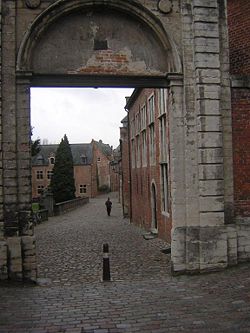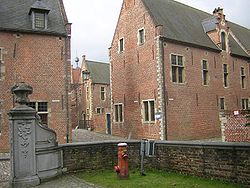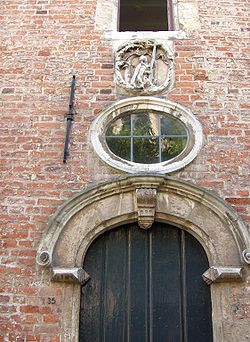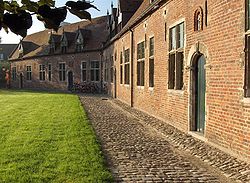
Grand Béguinage, Leuven
Encyclopedia
The Grand Béguinage
of Leuven
(Dutch: Groot Begijnhof van Leuven) is a well preserved and completely restored historical quarter containing a dozen of streets in the south of downtown Leuven. About 3 hectares (7.5 acres) in size, with some 300 apartments in almost 100 houses, it is one of the largest still existing beguinages in the Low Countries
. The béguinage stretches on both sides of the river Dijle
, which splits into two canals inside the béguinage, thus forming an island. Three bridges connect the parts of the beguinage. The complete béguinage is owned by the University of Leuven and used as a campus, especially for housing students and academic guests.
, mention 1205 as founding date.
Just like other béguinages in Flanders, the béguinage in Leuven had a first golden age in the 13th century, and difficult times during the religious conflicts in the 16th century. One of the priests of this béguinage was Adriaan Florensz. Boeyens, spiritual tutor of the infant Charles V
and later known as pope Adrian VI
.
From the end of the 16th century, and especially after the Twelve Years' Truce
in 1621, the Béguinage had a second flourishing period, culminating near the last quarter of the 17th century and continuing afterwards, be it in a gradual decline, until the invasion of the anti-religious French Revolution
arists. The peak in entries occurred with a time span of two generations in the period 1650-1670, when the number of beguines reached 360
. Near 1700, the number had already fallen back to 300, due to warfare (including the Nine Years War) and diseases. By the mid of the 18th century, the number of béguines was further reduced to approximately 250. The sudden increase in entries, followed by a long period of gradual decline, explains the homogeneity in the architectural style of the houses, most of which were constructed in the years 1630-1670. The same demographic evolution can be seen in other béguinages, such as in the nearby town of Diest
, or - with some delay - in Lier
(where the houses are on the average half a century younger than in Leuven). After the invasion of the French revolutionarists, the béguinage of Leuven was not sold as bien national, as happened with most monasteries and abbeys. The properties of the community were, however, confiscated and attributed to the local welfare commission (the Hospices civiles) and reorganised as civil almshouses. Beguines were allowed to continue to live in their houses but free rooms were rented to elderly and poor people. Quite some former clerics lived their mandatory pension in the béguinage, among them the last prior
of the abbey of Villers.
The last priest of the Beguine community died in 1977 at the age of 107. He is buried in the graveyard of Park Abbey
. The last Beguine died in 1988.


 After more than 150 years in use by the local welfare commission and being inhabited by people not financially able to maintain the dwellings, the place was in deplorable state in 1960. The welfare commission decided to sell the complete quarter. A Real-estate developer showed interest but abandoned his plans when he learnt that university wanted to buy and restore the béguinage. The restoration proceeded in two phases. The majority of the streets were restored in the 1960s and 1970s, under supervision of professor Lemaire. The church and the street next to it were restored in 1980's. The large scale restoration project of an entire quarter, and according to the principles of the Venice Charter
After more than 150 years in use by the local welfare commission and being inhabited by people not financially able to maintain the dwellings, the place was in deplorable state in 1960. The welfare commission decided to sell the complete quarter. A Real-estate developer showed interest but abandoned his plans when he learnt that university wanted to buy and restore the béguinage. The restoration proceeded in two phases. The majority of the streets were restored in the 1960s and 1970s, under supervision of professor Lemaire. The church and the street next to it were restored in 1980's. The large scale restoration project of an entire quarter, and according to the principles of the Venice Charter
was an important momentum in the popularity of béguinages and traditional architecture in general.


 The Grand Béguinage of Leuven has the appearance of a small town on its own, with houses planned along a network of narrow streets and small squares. This is in contrast to the béguinages of Bruges
The Grand Béguinage of Leuven has the appearance of a small town on its own, with houses planned along a network of narrow streets and small squares. This is in contrast to the béguinages of Bruges
and Amsterdam
, where all houses face a central courtyard. The only large greenyard, on the left river bank, resulted from the demolition of some houses in the 19th century. Five houses date back from the 16th century, three of which still show timber framing. The house of Chièvres
was built in 1561, in accordance with he will of Maria van Hamal, widow of William de Croÿ
, duke of Aarschot
and advisor in political affairs of Emperor Charles V
. The characteristic tented roof with the onion-shaped top, refers to the two towers of the duke's castle in Heverlee (today known as Arenberg Castle
).
The majority of the houses dates back from the period 1630-1670. They were constructed in the local, traditional architecture, enriched with some sober, baroque elements. The facades show red bricks with sandstone cross-bar frames for windows and doors. A typical element in the beguinage of Leuven are the numerous dormer
s, often elaborated with crow-stepped gable
s and round arched windows.
Many houses have strikingly few and small windows on the ground floor. The beguines were keen on their privacy. Houses with large windows on the ground floor used to be hidden by an additional wall, as is still the case in other beguinages.
A few houses were replaced or constructed in the 19th century, but far less than in other béguinages, such as in Lier.
The church is an early Gothic
basilica with Romanesque
elements. As usual for mendicant orders or women's congregations, it has no tower, only a flèche
. Since 1998, this flèche has carried a small carillon
, which plays a béguine-related melody every half an hour. The north entrance of the church shows two Latin inscriptions indicating the foundation years of beguinage (1234 - anno domini MCCXXXIIII curia incepit) and church (1305). The east end of the church has a strikingly tall 14th century quire window, whose upper part illuminates the attic above the groin vault constructed in the 17th century. The interior is 27 meter wide (the widest church in town) containing a nave and two aisles of ten bays. Daylight is prominently present. The arcades separating nave from aisles carry statues of the twelve apostles, Mary and Saint Joseph with the holy child. These statues, as most other artwork, are sober baroque. They are accentuated by artificial shades in black paint behind them. The restoration in the 1980s revealed 14th century murals.
 The name of the quarter of the béguinage, Ten Hove (Hof = Court), as well as the old name of the left river bank (Aborg = Vetus Castellum = Old Castle) seem to refer to previous settlement, possibly the court of the first Lords of Leuven. This would then have been the field where the battle of Leuven
The name of the quarter of the béguinage, Ten Hove (Hof = Court), as well as the old name of the left river bank (Aborg = Vetus Castellum = Old Castle) seem to refer to previous settlement, possibly the court of the first Lords of Leuven. This would then have been the field where the battle of Leuven
has taken place. In 891, the emperor Arnulf of Carinthia
ended here in the invasions of the Vikings. No hard evidence for the hypothesis was ever found in the Beguinage, and so, some authors contest the present day béguinage as being the precise location of the battle.
Béguinage
A béguinage or begijnhof is a collection of small buildings used by Beguines. These were various lay sisterhoods of the Roman Catholic Church, founded in the 13th century in the Low Countries, comprising religious women who sought to serve God without retiring from the world.-Description:A...
of Leuven
Leuven
Leuven is the capital of the province of Flemish Brabant in the Flemish Region, Belgium...
(Dutch: Groot Begijnhof van Leuven) is a well preserved and completely restored historical quarter containing a dozen of streets in the south of downtown Leuven. About 3 hectares (7.5 acres) in size, with some 300 apartments in almost 100 houses, it is one of the largest still existing beguinages in the Low Countries
Low Countries
The Low Countries are the historical lands around the low-lying delta of the Rhine, Scheldt, and Meuse rivers, including the modern countries of Belgium, the Netherlands, Luxembourg and parts of northern France and western Germany....
. The béguinage stretches on both sides of the river Dijle
Dijle
Dyle or Dijle or historically the River Dyle in English, is a river in central Belgium, left tributary of the Rupel. It is long. It flows through the Belgian provinces of Walloon Brabant, Flemish Brabant and Antwerp...
, which splits into two canals inside the béguinage, thus forming an island. Three bridges connect the parts of the beguinage. The complete béguinage is owned by the University of Leuven and used as a campus, especially for housing students and academic guests.
History
As a community for unmarried, semi-religious women (see Béguine), this béguinage originated in the early 13th century. The oldest written documents date back from 1232. A Latin inscription on the church mentions 1234 as founding date. The community is presumably a few decades older. Local historians from the 16th century, including Justus LipsiusJustus Lipsius
Justus Lipsius was a Southern-Netherlandish philologist and humanist. Lipsius wrote a series of works designed to revive ancient Stoicism in a form that would be compatible with Christianity. The most famous of these is De Constantia...
, mention 1205 as founding date.
Just like other béguinages in Flanders, the béguinage in Leuven had a first golden age in the 13th century, and difficult times during the religious conflicts in the 16th century. One of the priests of this béguinage was Adriaan Florensz. Boeyens, spiritual tutor of the infant Charles V
Charles V, Holy Roman Emperor
Charles V was ruler of the Holy Roman Empire from 1519 and, as Charles I, of the Spanish Empire from 1516 until his voluntary retirement and abdication in favor of his younger brother Ferdinand I and his son Philip II in 1556.As...
and later known as pope Adrian VI
Pope Adrian VI
Pope Adrian VI , born Adriaan Florenszoon Boeyens, served as Pope from 9 January 1522 until his death some 18 months later...
.
From the end of the 16th century, and especially after the Twelve Years' Truce
Twelve Years' Truce
The Twelve Years' Truce was the name given to the cessation of hostilities between the Habsburg rulers of Spain and the Southern Netherlands and the Dutch Republic as agreed in Antwerp on 9 April 1609. It was a watershed in the Eighty Years' War, marking the point from which the independence of the...
in 1621, the Béguinage had a second flourishing period, culminating near the last quarter of the 17th century and continuing afterwards, be it in a gradual decline, until the invasion of the anti-religious French Revolution
French Revolution
The French Revolution , sometimes distinguished as the 'Great French Revolution' , was a period of radical social and political upheaval in France and Europe. The absolute monarchy that had ruled France for centuries collapsed in three years...
arists. The peak in entries occurred with a time span of two generations in the period 1650-1670, when the number of beguines reached 360
. Near 1700, the number had already fallen back to 300, due to warfare (including the Nine Years War) and diseases. By the mid of the 18th century, the number of béguines was further reduced to approximately 250. The sudden increase in entries, followed by a long period of gradual decline, explains the homogeneity in the architectural style of the houses, most of which were constructed in the years 1630-1670. The same demographic evolution can be seen in other béguinages, such as in the nearby town of Diest
Diest
Diest is a city and municipality located in the Belgian province of Flemish Brabant. Situated in the northeast of the Hageland region, Diest neighbours the provinces of Antwerp to its North, and Limburg to the East and is situated around 60km from Brussels. The municipality comprises the city of...
, or - with some delay - in Lier
Lier, Belgium
Lier is a municipality located in the Belgian province of Antwerp. The municipality comprises the city of Lier proper and the village of Koningshooikt. On January 1, 2010 Lier had a total population of 33,930. The total area is 49.70 km² which gives a population density of 669 inhabitants per...
(where the houses are on the average half a century younger than in Leuven). After the invasion of the French revolutionarists, the béguinage of Leuven was not sold as bien national, as happened with most monasteries and abbeys. The properties of the community were, however, confiscated and attributed to the local welfare commission (the Hospices civiles) and reorganised as civil almshouses. Beguines were allowed to continue to live in their houses but free rooms were rented to elderly and poor people. Quite some former clerics lived their mandatory pension in the béguinage, among them the last prior
Prior
Prior is an ecclesiastical title, derived from the Latin adjective for 'earlier, first', with several notable uses.-Monastic superiors:A Prior is a monastic superior, usually lower in rank than an Abbot. In the Rule of St...
of the abbey of Villers.
The last priest of the Beguine community died in 1977 at the age of 107. He is buried in the graveyard of Park Abbey
Park Abbey
Park Abbey is a Premonstratensian abbey in Belgium, at Heverlee just south of Leuven, in Flemish Brabant.The Annales Parchenses were written here in the 12th century.-History:...
. The last Beguine died in 1988.


Restoration

Venice Charter
The Venice Charter for the Conservation and Restoration of Monuments and Sites is a treaty that gives an international framework for the preservation and restoration of ancient buildings...
was an important momentum in the popularity of béguinages and traditional architecture in general.
Architecture



Bruges
Bruges is the capital and largest city of the province of West Flanders in the Flemish Region of Belgium. It is located in the northwest of the country....
and Amsterdam
Begijnhof, Amsterdam
The Begijnhof is one of the oldest inner courts in the city of Amsterdam. A group of historic buildings, mostly private dwellings, centre on it. As the name suggests, it was originally a Béguinage...
, where all houses face a central courtyard. The only large greenyard, on the left river bank, resulted from the demolition of some houses in the 19th century. Five houses date back from the 16th century, three of which still show timber framing. The house of Chièvres
Chièvres
Chièvres is a Walloon municipality located in the Belgian province of Hainaut. On January 1, 2006 Chièvres had a total population of 6,198. The total area is 46.91 km² which gives a population density of 132 inhabitants per km²....
was built in 1561, in accordance with he will of Maria van Hamal, widow of William de Croÿ
William de Croÿ
William II de Croÿ, Lord of Chièvres , later Duke of Sora and Arce, Baron of Roccaguglielma William II de Croÿ, Lord of Chièvres (1458 – 28 May 1521) (also known as: Guillaume II de Croÿ, sieur de Chièvres in French; Guillermo II de Croÿ, señor de Chièvres, Xevres or Xebres in Spanish;...
, duke of Aarschot
Aarschot
Aarschot is a city and municipality in the province of Flemish Brabant, in Flanders, one of the three regions of Belgium. The municipality comprises the city of Aarschot proper and the towns of Gelrode, Langdorp and Rillaar. On January 1, 2006 Aarschot had a total population of 27,864...
and advisor in political affairs of Emperor Charles V
Charles V, Holy Roman Emperor
Charles V was ruler of the Holy Roman Empire from 1519 and, as Charles I, of the Spanish Empire from 1516 until his voluntary retirement and abdication in favor of his younger brother Ferdinand I and his son Philip II in 1556.As...
. The characteristic tented roof with the onion-shaped top, refers to the two towers of the duke's castle in Heverlee (today known as Arenberg Castle
Arenberg Castle
Arenberg Castle is a castle in Heverlee close to Leuven in Belgium. It is surrounded by a park.-History:The site had been the castle of the lords of Heverlee since the 12th century, but this family became impoverished and had to sell the site in 1445 to the Croÿ family from Picardy...
).
The majority of the houses dates back from the period 1630-1670. They were constructed in the local, traditional architecture, enriched with some sober, baroque elements. The facades show red bricks with sandstone cross-bar frames for windows and doors. A typical element in the beguinage of Leuven are the numerous dormer
Dormer
A dormer is a structural element of a building that protrudes from the plane of a sloping roof surface. Dormers are used, either in original construction or as later additions, to create usable space in the roof of a building by adding headroom and usually also by enabling addition of windows.Often...
s, often elaborated with crow-stepped gable
Crow-stepped gable
A Stepped gable, Crow-stepped gable, or Corbie step is a stair-step type of design at the top of the triangular gable-end of a building...
s and round arched windows.
Many houses have strikingly few and small windows on the ground floor. The beguines were keen on their privacy. Houses with large windows on the ground floor used to be hidden by an additional wall, as is still the case in other beguinages.
A few houses were replaced or constructed in the 19th century, but far less than in other béguinages, such as in Lier.
The church is an early Gothic
Gothic architecture
Gothic architecture is a style of architecture that flourished during the high and late medieval period. It evolved from Romanesque architecture and was succeeded by Renaissance architecture....
basilica with Romanesque
Romanesque architecture
Romanesque architecture is an architectural style of Medieval Europe characterised by semi-circular arches. There is no consensus for the beginning date of the Romanesque architecture, with proposals ranging from the 6th to the 10th century. It developed in the 12th century into the Gothic style,...
elements. As usual for mendicant orders or women's congregations, it has no tower, only a flèche
Flèche
A flèche is used in French architecture to refer to a spire and in English to refer to a lead-covered timber spire, or spirelet. These are placed on the ridges of church or cathedral roofs and are usually relatively small...
. Since 1998, this flèche has carried a small carillon
Carillon
A carillon is a musical instrument that is typically housed in a free-standing bell tower, or the belfry of a church or other municipal building. The instrument consists of at least 23 cast bronze, cup-shaped bells, which are played serially to play a melody, or sounded together to play a chord...
, which plays a béguine-related melody every half an hour. The north entrance of the church shows two Latin inscriptions indicating the foundation years of beguinage (1234 - anno domini MCCXXXIIII curia incepit) and church (1305). The east end of the church has a strikingly tall 14th century quire window, whose upper part illuminates the attic above the groin vault constructed in the 17th century. The interior is 27 meter wide (the widest church in town) containing a nave and two aisles of ten bays. Daylight is prominently present. The arcades separating nave from aisles carry statues of the twelve apostles, Mary and Saint Joseph with the holy child. These statues, as most other artwork, are sober baroque. They are accentuated by artificial shades in black paint behind them. The restoration in the 1980s revealed 14th century murals.
Ten Hove and Aborg

Battle of Leuven
The Battle of Leuven was fought in September 891 between the Franks and the Vikings, essentially ending the Viking invasions in the Low countries. The existence of this battle is known due to the Annales Fuldenses.-The battle:...
has taken place. In 891, the emperor Arnulf of Carinthia
Arnulf of Carinthia
Arnulf of Carinthia was the Carolingian King of East Francia from 887, the disputed King of Italy from 894 and the disputed Holy Roman Emperor from February 22, 896 until his death.-Birth and Illegitimacy:...
ended here in the invasions of the Vikings. No hard evidence for the hypothesis was ever found in the Beguinage, and so, some authors contest the present day béguinage as being the precise location of the battle.
Sources
This article is based on the Dutch Wikipedia article on Groot Begijnhof (Leuven).External links
- Belgium's beguinages were once refuges for women USA TodayUSA TodayUSA Today is a national American daily newspaper published by the Gannett Company. It was founded by Al Neuharth. The newspaper vies with The Wall Street Journal for the position of having the widest circulation of any newspaper in the United States, something it previously held since 2003...
- Groot Begijnhof Leuven, a brief history
- Map Grand Beguinage

